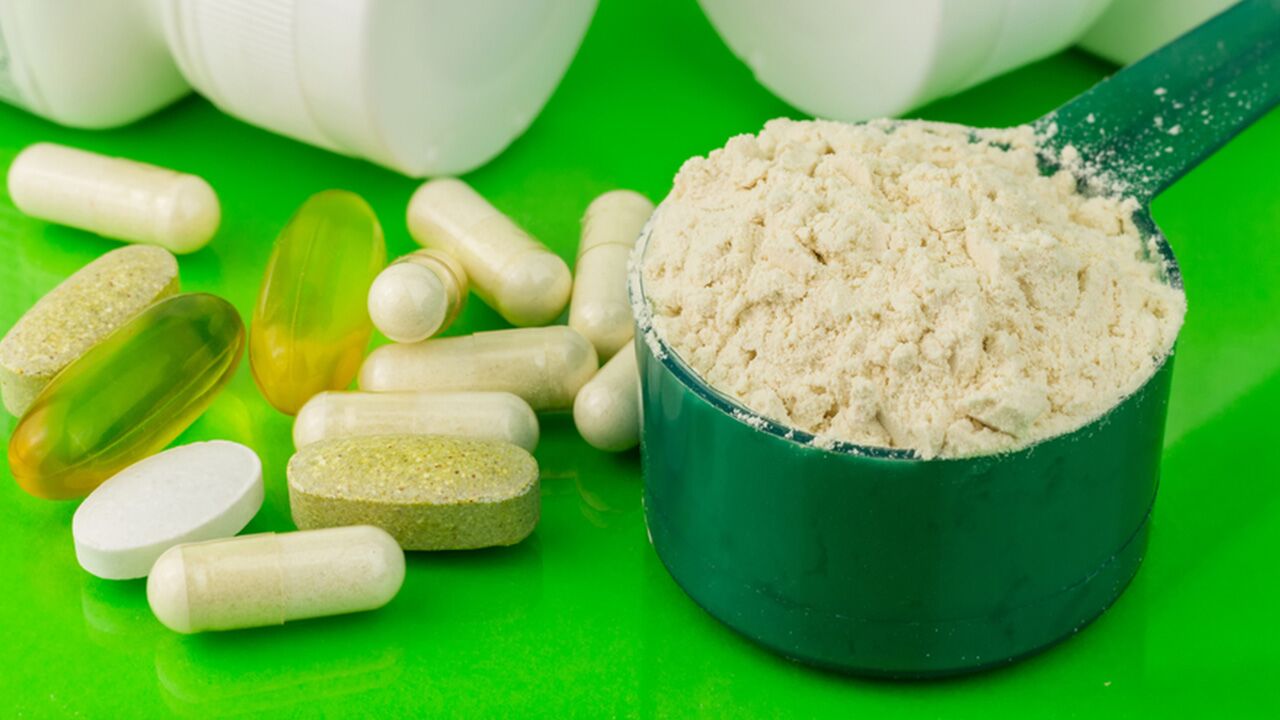How Amino Acids Support Female Muscle Growth
 By: by Amino Science
By: by Amino Science

Female muscle growth. It's not a phrase you hear too often. However, whether you're a man or a woman, muscle building benefits your overall health and well-being. Strong scientific evidence shows that increasing your lean muscle mass can help you stay healthy as you age, support fat loss by keeping your metabolism running at full capacity and prevent the development of chronic diseases.
If you're born male, you're coached from a young age to want to grow up to be big and strong. But if you're born female, you receive the opposite message. With the emergence of ripped and toned female fitness influencers taking social media by storm, the tides appear to be shifting. Nonetheless, society still tends to instruct girls to train themselves to be as dainty as possible—in part, so they can grow up to be women who attract big, strong men.
But the health benefits of muscle mass apply to everyone, regardless of gender. However, it can be more challenging for women to build muscle for a variety of reasons.
In this article, we'll explore the scientific realities behind the common belief that muscle building comes more naturally to men than to women. Plus, we'll offer tips that everyone can use to increase their physical strength and get serious muscle growth results.
Do Men Build Muscle More Easily Than Women?
If you're at all familiar with the resources out there for people interested in muscle building, you've probably noticed that the vast majority of it is written by male authors for male audiences. While that has begun to shift somewhat as more women get into powerlifting, bodybuilding, and sports science, these realms are still dominated by men.
In those realms, a concept that many take for granted is that muscle gains come more easily for men than for women. This concept is propped up by claims that men and women have significant physiological differences that give men an advantage when it comes to physical strength and performance.

What Science Tells Us About the Differences Between Men and Women
Let's begin by comparing the average metabolic rates—the calories you burn just by going about your day—for men and women. According to a study published in the American Journal of Clinical Nutrition, about 90% of the variations researchers identified in the baseline number of calories participants expended over a 24-hour period came down to differences in fat mass and muscle mass. Your age has a measurable impact too. Researchers found that participants between 50 and 65 years of age had baseline metabolic rates that were 4.6% lower than participants between the ages of 20 and 30.
Fascinatingly, they reported: "No sex difference in any energy expenditure measurement could be found." However, women do tend to have slower metabolisms than men, but it's not because they're women, it's because on average, women are smaller and have less muscle mass.
So, let's look into muscle mass differences. Findings published in the Journal of Applied Physiology reveal that women have, on average, about 67% of the muscle mass men do.
Women lag further behind when it comes to the muscle groups of the upper body than those of the lower body. A research team from the departments of Physical Education and Medicine at McMaster University in Hamilton, Canada set out to determine how gender differences influence strength and muscle fiber characteristics. They found that female participants had approximately 52% of the upper body strength and 66% of the lower body strength of men.
These differences appear to have more to do with the likelihood that men will have larger muscles than with innate sex-based differences, though. A study published in Ergonomics sought to measure the extent to which differences in strength between men and women can be explained by muscle size. Researchers found that when they adjusted their findings to take into account overall muscle mass as well as the size of specific muscle groups, 97% of sex-related differences were in strength. The researchers state that their findings suggest muscle size "almost entirely" accounts for the differences we expect to see between a man's physical strength and a woman's. In other words, if a man and woman have comparable muscle mass, they should be equally strong.
It appears that the vast majority of the differences we attribute to sex actually have to do with body composition. A woman and man with similar previous experience in terms of physical activity and comparative amounts of muscle and fat will perform similarly on standard measures of strength.
However, there are some differences between the ways men's bodies and women's bodies tend to respond to strength-training regimens and individual workout plans.
How Hormones Affect Female Muscle Growth
Hormones tend to be the first factor people point to when talking about physiological differences between women and men. It's only logical, given that men's increased muscle mass results from higher testosterone levels. Hormone levels fluctuate from person to person and over time, but on average, women produce far less testosterone than men do—between 15 and 20 times less, according to data sourced from the U.S. National Library of Medicine.
However, the question of testosterone levels isn't as clear cut as we tend to think. In fact, some men have lower testosterone levels than some women do. After a team of researchers from the U.K. analyzed the hormone levels of elite athletes, they found significant overlap between testosterone levels for male competitors and female competitors. It's worth noting that the hormone profiles of elite athletes differ from those of average individuals. It's also highly likely that women with naturally higher levels of testosterone are more likely to excel at the elite level in certain physical disciplines. The main takeaway is that the idea that men have higher testosterone levels and therefore build new muscle more easily doesn't entirely hold up.
Furthermore, did you know that testosterone is not the only hormone involved in building muscle mass? Estrogen, which as you may know, women typically produce at higher levels than men do, has also been shown to have significant benefits for muscle growth.
Studies done with animal subjects and well-controlled studies with human subjects support the idea that estrogen can help to prevent the breakdown of muscle tissue that often accompanies the aging process. It appears that estrogen has an overall positive impact when it comes to maintaining and increasing your lean muscle mass.
And an article published in Exercise and Sport Sciences Reviews presented experimental findings suggesting that estrogen may have an anabolic effect on muscles, meaning it supports muscle gain. It appears to do this primarily by lowering protein turnover, which slows the rate of catabolism (muscle breakdown), and enhancing the sensitivity of muscle tissue to resistance training.
Estrogen also boosts your metabolism, making it easier to cut your body fat percentage. While that doesn't directly contribute to muscle growth, it does mean the new muscles you build will be more visible.
Women and Men Build Different Types of Muscles
We all have two general types of skeletal muscle fibers: slow-twitch, or Type 1, and fast-twitch, or Type 2. Type 1 muscles help power you through feats of endurance, like marathons. And the more Type 2 muscles you have, the better you perform on tests of explosive strength, like Olympic weight training.
There's a clear divide between the average percentages of Type 1 and Type 2 muscle fibers that women and men typically have. According to Greg Nuckols, an experienced fitness writer who holds a BS in Exercise and Sports Science and three all-time world records for powerlifting, women typically have more Type 1 muscle fibers than men do, about 27% to 35% more. Women also tend to have greater capillary density.
Both give women an advantage in many ways. Greater capillary density means an increased ability to circulate blood through your muscle tissue to bring in fresh oxygen and clear out waste products. And having a higher percentage of Type 1 muscle fibers gives you an improved capacity for glucose and fatty acid oxidation, which translates to a decreased risk of chronic conditions linked to metabolic health, like diabetes and heart disease.
However, Type 2 muscle fibers are thicker, quicker to contract, and engage when your body nears maximum exertion. If you're looking to increase your muscle mass and build strength so you can lift heavier and heavier weights, you need to recruit your Type 2 muscles. There's no evidence that Type 1 muscle fibers can be transformed into Type 2 muscle fibers (or vice versa), which means there may always be a gap between the level of explosive strength an experienced female weight lifter can generate and the amount a male lifter at the same level can generate.
Maximizing Muscle Growth as a Woman
While men may have some innate advantages when it comes to building muscle mass, studies show that both men and women gain muscle at the same rate when they commit to workout routines like resistance training, weight training, and high-intensity interval training (HIIT).
Researchers from the University of Maryland Exercise Science and Wellness Research Laboratories conducted a study in which participants committed to a 6-month, whole-body strength-training program that worked for all the major muscle groups in both the upper and lower bodies.
They used MRI images to assess thigh and quadriceps muscle volume as well as mid-thigh muscle cross-sectional area before and after the strength-training program. Their findings showed that the thigh and quadriceps muscle volume increased significantly for all age and gender groups as a result of the strength-training program. The researchers found no significant differences related to either participant age or gender.
In some cases, women can make more significant strength and muscle gains than men. A study published in the International Journal of Sports Medicine examined how men and women responded to weight-training and resistance-training approaches. The researchers found that after following the same short-term training program, female participants made more significant strength increases than male participants did.
For women interested in optimizing their body composition by decreasing their body fat percentages and increasing their muscle mass, there are certain strategies you can put in place to maximize your muscle-building potential.
Train Strategically
When it comes to building muscle, the first step is to institute a strength-training regimen. For those seeking to rapidly increase muscle growth who are comfortable and able to perform high-intensity workouts, the most effective strength-training approach will involve lifting increasingly heavy weights. That might mean using barbell, kettlebells, dumbbells, or other types of weights.
Incorporating weightlifting into your training sessions encourages muscle growth because of the strain it places on your muscles. This wear and tear breaks down the muscle tissues. Then, during the recovery process that takes place while you sleep and on rest days, your muscles rebuild themselves. Each time this process takes place, your muscles grow bigger and stronger.
Adding high-intensity interval training to your exercise routine can also increase your muscle gains. This method of training involves short burst of intense exertion—a great tactic for recruiting your Type 2 muscles.
Increase Your Protein Intake
As you know, your muscles are made up of proteins. In order for your muscles to successfully rebuild themselves after workouts, you need to provide them with an adequate supply of dietary protein.
There's no one-size-fits-all answer to the question of how much protein your muscles need to properly build and repair themselves. Factors like age, weight, activity level, and training goals will all influence the amount of protein an individual needs to consume.
Federal guidelines set the minimum recommended amount of protein consumption for adults at 17% to 21% of your daily calories, and that's without taking weight training into consideration.
As Jim White, RD, ACSM, explained, resistance training increases the process of protein turnover. By eating proteins laden with all the essential amino acids, you're providing your body with the raw materials it needs to build muscle.
According to the American College of Sports Medicine, if you're looking to build muscle mass, you should aim to consume between 0.5 and 0.8 grams of protein per pound of body weight. That means a 150-pound woman, for example, should set a protein intake target of 75-120 grams of protein each day. It's also important to consider the percentage of your overall calorie intake that comes from protein.
White, as well as other experts, recommends prioritizing the post-workout window for protein consumption as this has the biggest impact on muscle growth. Findings published in the Journal of the International Society of Sports Nutrition indicate that protein consumption before workouts can also be a key factor. Eating protein both before and after workouts can boost your performance, speed your recovery time, and increase your lean muscle mass.
Amino Acids Can Boost Female Muscle Growth
While it's entirely possible to meet your body's protein needs through diet alone, it can be helpful to add in high-quality supplements, including protein powders. Especially if you have a busy schedule that makes it challenging to consume enough protein during meal or snack times, it can be highly beneficial to provide your body with amino acids from other sources.
Researchers have found that certain supplements can be particularly helpful when it comes to building and maintaining muscle mass. If you're wondering about the best amino acids for muscle growth, here are three to consider.

1. Creatine
Creatine, an amino acid compound found naturally in the human body as well as in foods like red meat, has been the subject of hundreds of studies. If you're lifting weights and looking to amplify your results, you may want to consider supplementing with creatine.
Media reports may have lead you to believe that creatine supplementation can adversely impact the health of your kidneys, but scientists have repeatedly and conclusively found that not to be the case.
After going over all available data on the short-, medium-, and long-term effects of creatine supplementation, researchers from the Higher Institute of Physical Education and Readaptation in Brussels, Belgium found no evidence that creatine causes liver dysfunction in healthy individuals (individuals with pre-existing kidney disease should avoid creatine). The researchers concluded that individuals who take creatine "do not report any adverse effects, but body mass increases." They also noted that creatine may benefit the health of your heart and help reduce your risk of neurological diseases.
Studies show that supplementing with creatine can increase your lean body mass, enhance your anaerobic working capacity, and minimize the muscle damage caused by extreme exertion.
2. Beta-Alanine
This naturally occurring amino acid has also been the subject of extensive research.
One reason for this is that beta-alanine is the rate-limiting precursor of carnosine, an amino acid found in high concentrations in human skeletal muscle. One study on the effects of beta-alanine supplementation found that it can increase concentrations of carnosine in your muscles, which in turn helps to prevent muscular fatigue.
A separate study published in the Journal of the International Society of Sports Nutrition found pairing beta-alanine supplementation with high-intensity interval training (HIIT) can substantially increase both endurance and aerobic metabolism. It also showed a clear and impressive impact on subjects' lean muscle mass.
Plus, a third study that examined how beta-alanine impacted anaerobic power output by using tests of physical strength such as timed sprints and a 90° bent-arm hang found that supplementing with beta-alanine improved participants' results across all categories. Participants who supplemented with beta-alanine were able to achieve simultaneous weight loss and lean body mass increases.
3. Citrulline
Supplementing with citrulline can significantly increase your blood levels of not only this important amino acid, but two other crucial amino acids as well: ornithine and arginine. This can have a wide range of health benefits.
According to findings published in the The Journal of Strength & Conditioning Research, even a single dose of citrulline can improve your physical performance as measured by a flat barbell bench press. It can also reduce post-exercise muscle soreness. Participants were able to complete approximately 53% more repetitions and reported 40% less muscle soreness at both 24 and 48 hours afterward.
A separate study published in the British Journal of Sports Medicine showed that citrulline reduced muscular fatigue and improved muscle metabolism as measured by oxidative ATP production and the rate of phosphocreatine recovery after exercise.
All in all, it appears that this amino acid can improve endurance and speed up recovery time.
Greater Than the Sum of the Parts
Your muscles aren't composed of single amino acids, but rather 20 separate amino acids. Building muscle mass requires a steady supply of all those amino acids. Nine of those are essential amino acids, meaning you must get them from the foods you eat or supplements you take.
While certain amino acids have been shown to have more dramatic results when it comes to muscle growth, your rate of muscle protein synthesis will be limited by whichever essential amino acid is in the shortest supply. That's why some of the foremost experts on amino acids believe that taking an essential amino acid (EAA) blend is ultimately the most effective way to build your muscle mass. Using a supplement formulated to include all the required amino acid building blocks stimulates the production of new muscle tissue more effectively than any single amino acid could.
The Amino Company has formulated this precise blend of essential amino acids, plus creatine and citrulline. Learn more about how Perform can boost athletic performance and muscle growth here.

Up to 25% off Amino
Shop NowTAGS: benefits
Join the Community
Comments (0)
Most Craveable Recipes




 833-264-6620
833-264-6620



















